Credit Where Credit is Due. What follows is a compilation of photos, information, and specifications gathered from ; Wikipedia www.wikipedia.com , The Encyclopedia of Oldsmobile http://encyclopedia.classicoldsmobile.com/ and varied photos posted on the internet.
![]()
THE TORONADO
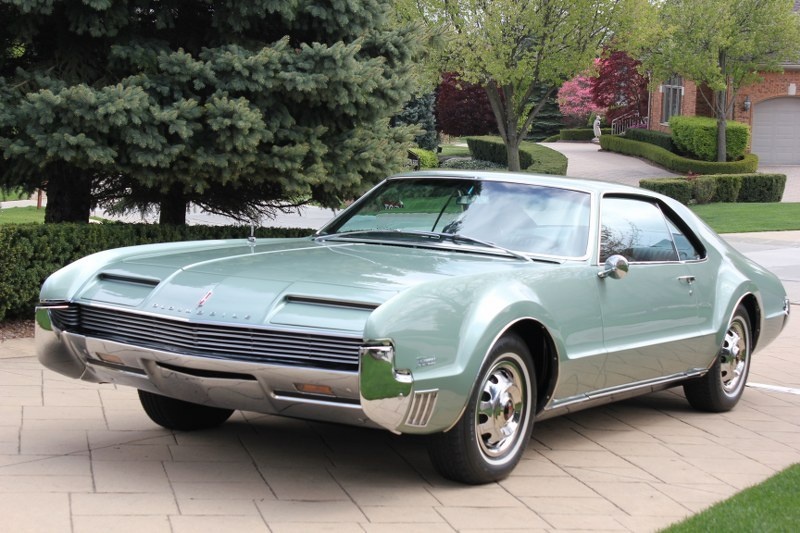

The Toronado was a two-door coupe produced by the Oldsmobile division of General Motors from 1966 to 1992.
The name "Toronado" has no meaning, and was originally invented for a 1963 Chevrolet show car. Conceived as Oldsmobile's full-size personal luxury car and competing directly with the Ford Thunderbird, the Toronado is historically significant as the first front-wheel drive automobile produced in the United States since the demise of the Cord in 1937.
The Toronado was structurally related to the 1966 rear-wheel-drive Buick Riviera and the following year's Cadillac Eldorado, although each had quite different styling. The Toronado continued to share its E-body platform with the Riviera and Eldorado for most of its 28-year history.
|
1966-1970
|
The original Toronado began as a design painting by Oldsmobile stylist David North in 1962. His design, dubbed the "Flame Red Car," was for a compact sports/personal car never intended for production. A few weeks after the design was finished, however, Oldsmobile division was informed it would be permitted to build a personal car in the Riviera/Thunderbird class for the 1966 model year, and North's design was selected. For production economy, the still-unnamed car was to share the so-called E-body shell with the redesigned 1966 Buick Riviera, which was substantially bigger than North had envisioned. Despite the efforts of Oldsmobile and General Motors styling chief Bill Mitchell to put the car on the smaller A-body intermediate, they were overruled for cost reasons.
Oldsmobile had been working on front-wheel drive since 1958, a project shepherded by engineer John Beltz (who originated the 442 and would later become head of the division). Although initially envisioned for the smaller F-85 line, its cost and experimental nature pushed the program towards a larger, more expensive car. Engineer F. J. Hooven of the Ford Motor Company, had patented a similar FWD layout, and Ford was seriously considering the design for the 1961 Ford Thunderbird. However, the time to develop and engineer such a design in such short notice made this a doubtful proposition.
Oldsmobile spent seven years developing the Toronado. Prior to its introduction to the public, over 1.5 million brutal test miles had been performed to verify the strength and reliability of the Toronado's front-drive components. Obviously, Oldsmobile did not want anyone to experience problems with the new design. History has confirmed the Toronado design was indeed heavily over-built; the GMC motorhome of the 1970s, which used a basically unchanged Toronado-derived drivetrain, stands as a testament to that fact. Nevertheless, the re-introduction of front wheel drive earned the new Toronado Motor Trend "Car of the Year" honors in 1966.
Naming the Toronado was also an event in itself. Some other known names being considered during development are: Magnum (later used by Dodge), Scirocco (later used by Volkswagen) and Raven.
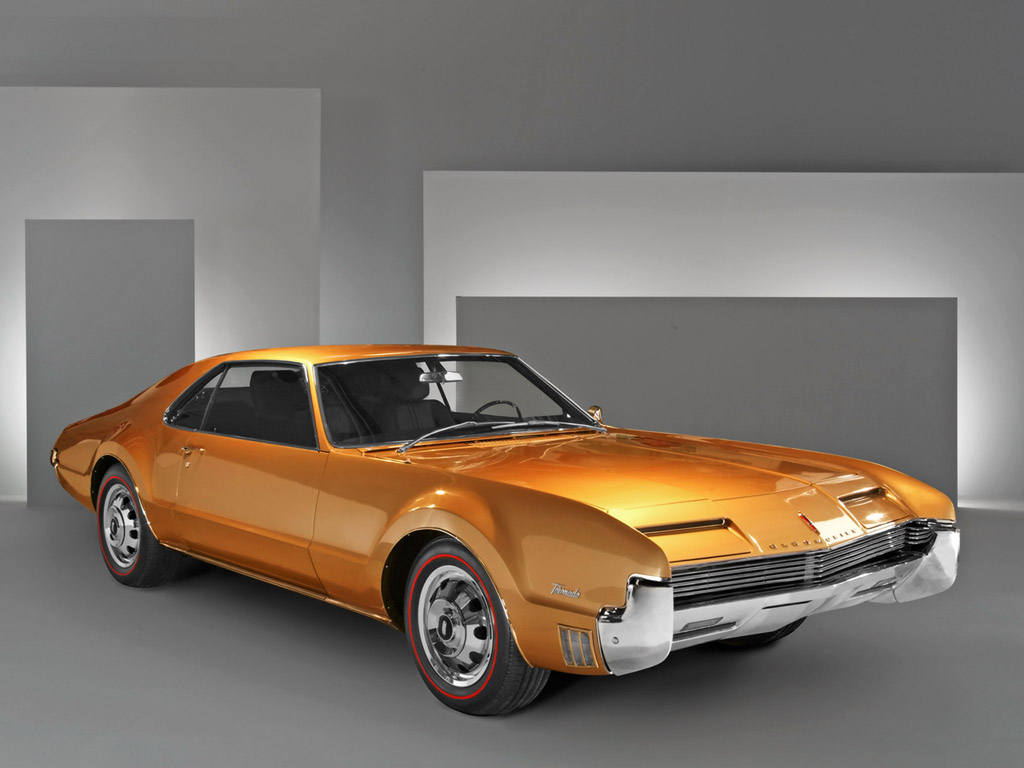
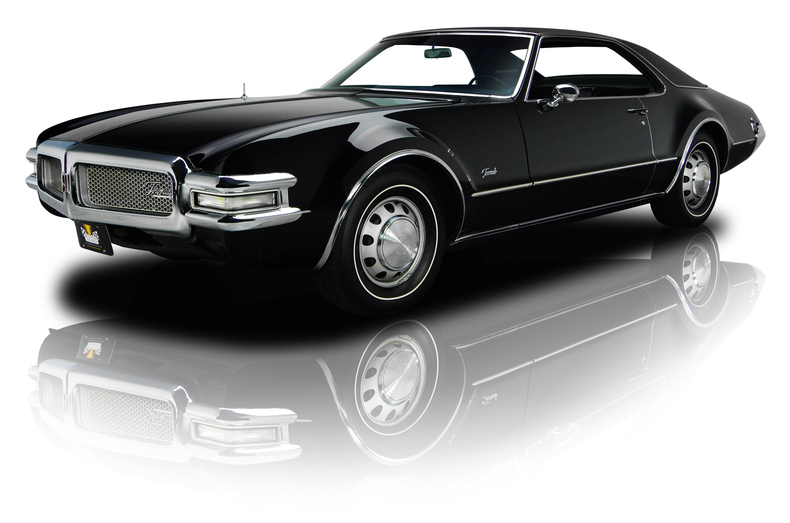
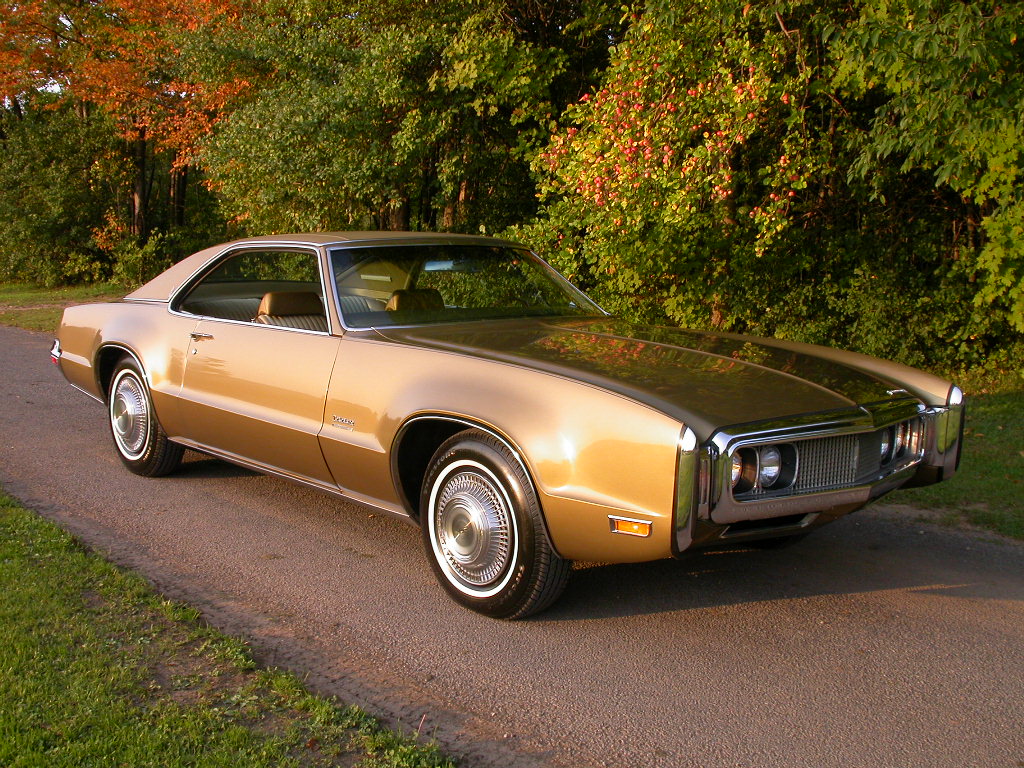
Jay Leno's 1966 1968 1970 GT
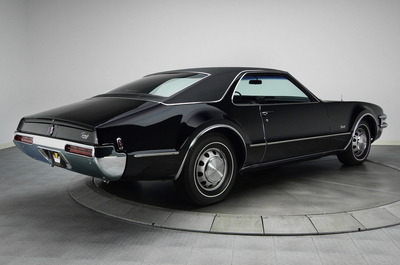
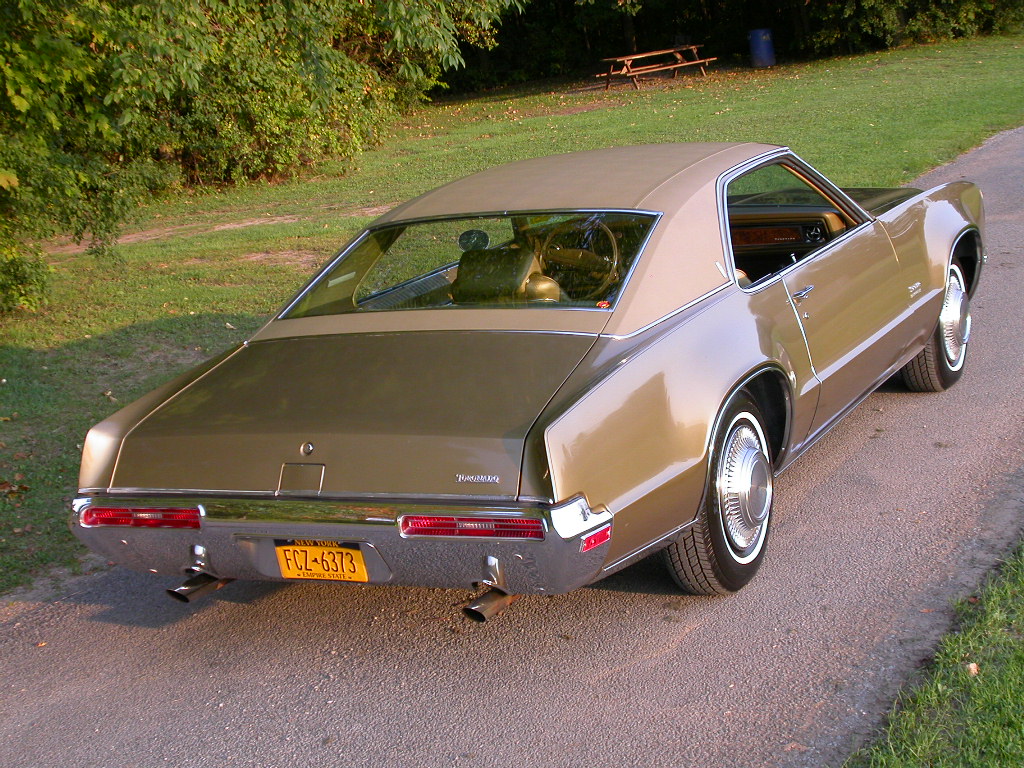
68 70
During its seven-year development period, several General Motors innovations and designs came about because of the Toronado:
Heavy-duty Turbo-Hydramatic 400 3-speed automatic transmission (named THM425 in FWD form)
Rochester Quadrajet 4-barrel carburetor
Spherical shaped exhaust-manifold flange gaskets, which provided freedom of movement in the exhaust system and prevented leaks
"Draft-Free" ventilation system, which reduced wind noise considerably by eliminating the conventional front-door vent windows
The unusual Toronado powertrain was dubbed the Unitized Power Package (UPP). It was designed to combine an engine and transmission into an engine bay no larger than a conventional rear-wheel drive car.
To power the car, Oldsmobile engineers selected a conventional, although performance-boosted, Olds 425 cu in (7.0 L) Super Rocket V8 rated at 385 hp and 475 ft·lb of torque. It provided an increase of 10 hp over the Starfire 425, and an increase of 20 hp over the standard 425 engine in the Ninety-Eight. The Toronado's intake manifold was unique and was depressed down to allow for engine hood clearance.
The Turbo-Hydramatic heavy-duty 3-speed automatic transmission, (or THM400, TH400) came about during development of the Toronado. Called the TH425 in FWD form, the transmission's torque converter was separated from its planetary gear set, with the torque converter driving the gear set through a 2" wide silent chain-drive called Hy-Vo, riding on two 12" sprockets. The Hy-Vo chain drive was developed by GM's Hydra-Matic Division and Morse Chain Division of Borg-Warner. The chains were made from a very strong hardened steel and required no tensioners or idler pulleys because they were pre-stretched on a special machine at the factory. Although the rotation direction of the transmission's gearing had to be reversed, a large number of components were shared with the conventional TH400. Use of the automatic also obviated the need to devise a workable manual-shift linkage; no manual transmission was ever contemplated, as engineers deemed performance to be adequate with the automatic transmission and the fact that virtually all U.S.-built luxury cars during this period came with automatic transmissions as standard equipment.
The Toronado was GM's first subframe automobile, which means it was partly unitized, and used a subframe that ended at the forward end of the rear suspension leaf springs, serving as an attachment point for the springs. It carried the powertrain, front suspension and floorpan, allowing greater isolation of road and engine harshness (the design was conceptually similar to the Chevrolet Camaro and Pontiac Firebird that would debut for 1967).
For space reasons, Oldsmobile adopted torsion bars for the Toro's front suspension (the first GM passenger car application of torsion bars), with conventional, unequal-length double wishbones. Rear suspension was a simple beam axle on single leaf springs, unusual only in having dual shock absorbers, one vertical, one horizontal (allowing it to act as a radius rod to control wheel movement).
Brakes were conventional drums of 11 inch (279 mm) diameter), which were generally considered the Toronado's weak link. Being a rather heavy car, after several panic stops, the brake drums would overheat, resulting in considerable fade and long stopping distances. The 1967 addition of front vented disc brakes as an option provided substantial improvement.
The Toronado's UPP enabled the interior to have a completely flat floor, but interior space (primarily rear seat headroom) was somewhat restricted by the fastback styling. Although a two door coupe, the Toronado featured elongated doors, allowing easier access for passengers boarding the rear seating area. Even rear-mounted handles were available optionally to enable rear-seat passengers to open the doors without reaching across the front seat back; this feature was also available on Chrysler Imperial cars of the era. Head rests were optional for $52. Also optional was a tilt-telescopic steering wheel.
Drivers faced a highly stylized steering wheel with a double-delta shaped horn ring, which framed the view of an unusual speedometer which consisted of a stationary indicator "needle" and a vertically rotating drum on which the numerals were printed. All other gauges, indicators and controls were grouped within fairly easy reach of the driver.
Despite an average test-weight approaching 5,000 lb, published performance test data shows the 1966 Toronado was capable of accelerating from 0–60 mph in 7.5 seconds, and through the standing 1/4 mile in 16.4 seconds at 93 mph. It was also capable of a maximum speed of 135 mph. Testers found the Toro's handling, despite its noticeable front weight bias and consequent understeer, was not substantially different from other full-size American cars when driven under normal conditions. In fact, many contemporary testers felt that the Toronado was more poised and responsive than other cars, and when pushed to the limits, exhibited superior handling characteristics, although it was essentially incapable of terminal oversteer.
A special option code called W-34 was available on the 1968–70 Toronado. This option included a cold air induction system for the air cleaner, a special performance camshaft and a "GT" transmission calibrated for quick and firm up-shifts and better torque multiplication at 5 mph (8 km/h). Dual exhaust outlets similar to the 1966–67 model years with cutouts in the bumper were also included with W-34. The standard models did have dual exhaust systems, but only a single somewhat hidden outlet running from the muffler exiting rearward on the right side. For 1970 only, the W-34 option also included special "GT" badges on the exterior of the car. The W-34 Toronado was capable of 0–60 mph in 7.5 seconds and the standing 1/4 mile in 15.7 seconds at 89.8 mph (144.5 km/h).
The Toronado sold reasonably well at introduction, with 40,963 produced for 1966. The car also gained great publicity for the division by winning several leading automotive awards, such as Motor Trend's Car of the Year Award and Car Life's Award for Engineering Excellence. It also was a third-place finisher in the European Car of the Year competition.
Sales for the 1967 model, which was most notably distinguished by a slight facelift, the addition of optional disc brakes, and a slightly softer ride, dropped by nearly half, to 22,062. A stereo tape player was optional. It would be 1971 before the Toro would match its first-year sales mark.
The first-generation Toronado lasted with the usual annual facelifts through 1970. Other than the brakes, the major changes were the replacement of the original 425 cu in (7.0 L) V8 with the new 455 cu in (7.5 L) in 1968 that was rated at 375 hp in standard form or 400 hp with the W-34 option, revised rear quarter panels (with small fins to disguise the slope of the rear body in side view) in 1969, and the disappearance of hidden headlights and the introduction of squared wheel arch bulges in 1970. An ignition lock became standard in 1969.
Slight interior cosmetic changes were also implemented for each new model year, and a full-length center console with floor-mounted shifter was available as an extra-cost option with the Strato bucket seats from 1968 to 1970, though few Toronados were so ordered. The vast majority of customers went for the standard Strato bench seat to take full advantage of the flatter floor resulting from the front-drive layout; the lack of a "hump" in the floor made three-abreast seating more comfortable than in rear-drive cars, as the center passengers both front and rear did not have to sit with their legs in an awkward position.
The firmness of the suspension, and thus the quality of the ride, was gradually softened through the years as well, hinting at what Toronado eventually would become in 1971. Interestingly, a heavy-duty suspension was offered optionally on later first generation Toronados, which included the original torsion bar springs that were used on the 1966.
Manufacturer's specifications
1971-1978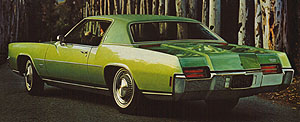 1972 Toronado |
1971 1972 1973 1974 1975 1976 1977 1978 |
With radically different styling than the first generation, the Toronado had changed from a "GT"-style car into something more traditional in the luxury car field. It was now more similar to the Cadillac Eldorado than the Buick Riviera, with styling taking several cues from the 1967-70 Eldorado. The new look attracted many new buyers, as sales increased dramatically. Front disc brakes became standard.
All overall dimensions of the '71 Toronado were larger than previous models with wheelbase increased from 119 to 122 inches, only two inches less than the full-sized Delta 88. Also, the subframe design of first-generation Toronados was replaced by a separate body-on-frame similar to full-sized Delta 88 and Ninety-Eight models. The front torsion bar suspension was retained, but the multi-leaf springs in the rear were replaced by coil springs. In addition, the Toronado introduced as a novelty what later became a federal mandate in a modified form, two high-mounted taillights above the trunk and below the rear window. These taillights mirrored brake and turn functions of the normal taillights, but not the nighttime taillights. Rear-wheel ABS became optional.
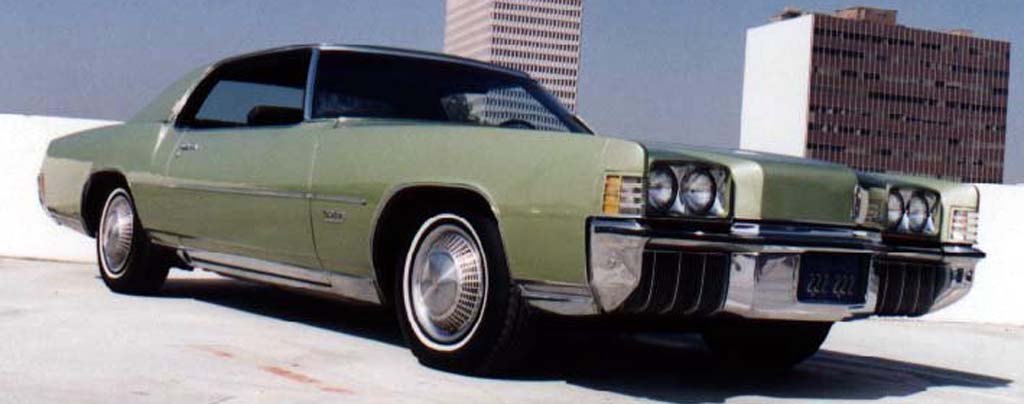

1971
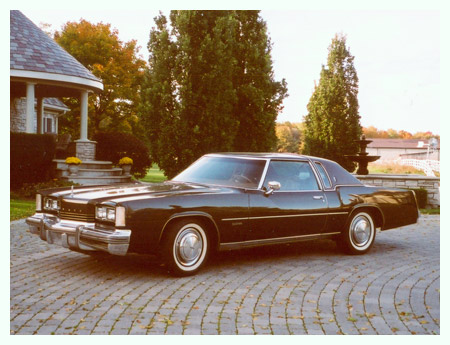
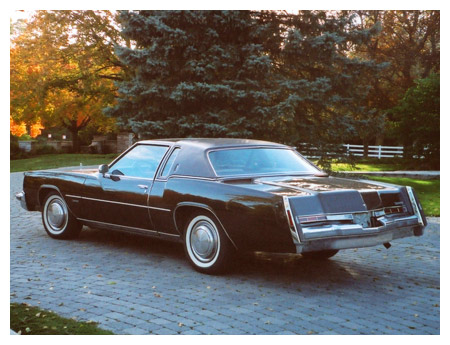
1975
The 455 cubic-inch Rocket V8 was carried over from previous models as the standard Toronado engine. The introduction of the second-generation Toronado coincided with the implementation of a GM corporate edict that took effect with the 1971 models; all engines had to run on lower-octane regular leaded, low lead or unleaded gasoline to meet increasing more stringent Federal (and California) emission control regulations, a goal that was reached by reducing compression ratios. This was a first step toward the introduction of catalytic converters in 1975, which mandated the use of unleaded fuel. .The'71 Toronado's 455 cubic-inch V8 was rated at 350 horsepower (down from 375 in 1970) with a compression ratio of 8.5 to 1 (down from 10.5 to 1 in 1970).
For 1972, the advertised horsepower rating for the 455 engine dropped to 250 thanks to a switch in power measurements from the gross ratings in which power was measured by a dynometer with no accessories attached to "net" ratings which were measured as installed in a vehicle with all accessories and emissions equipment attached. By 1976, (the last year for the 455 engine in the Toronado), the rating dropped to 215 net horsepower.
The 1971–78 generation is mainly noted for the early use of two safety features that are now required on all cars in the United States, the aforementioned high mounted taillights (although a somewhat similar feature had appeared briefly as an option on the Ford Thunderbird in the late 1960s), and from 1974 through 1976, the Toronado was part of GM's first experimental production run of driver- and passenger-side airbags, which GM named the Air Cushion Restraint System. These Toronados used a unique steering wheel and were fitted with a knee blocker beneath the driver's portion of the dashboard.
Styling and engineering highlights through the years included disc brakes with audible wear indicators for 1972, a federally-mandated 5 MPH front bumper along with new vertical taillights in 1973, a stand-up hood ornament, 5 MPH rear bumper and optional fixed rear side opera windows in 1974 and rectangular headlights in 1975.
During most of the Toronado's second-generation run, two interior trims were generally offered each year. The standard trim consisted of a choice of cloth or vinyl upholstery and a Custom Sport notchback bench seat with center armrest. An optional Brougham interior available in cloth, velour or vinyl trims included cut-pile carpeting, door-mounted courtesy lighting and a split 60/40 bench seat with armrest. From 1971 to 1973. The Toronado's "Command Center" wrap-around instrument panel was similar to other full-sized Oldsmobiles featuring a large squared speedometer directly in front of the driver, heating/air conditioning and lights/wipers switches on the left hand side and the radio controls and cigar lighter on the right hand side. From 1974 to 1978, a flat instrument panel (again shared with Delta 88 and Ninety-Eight models) was used that featured a horizontal sweep speedometer flanked by a "Message Center" of warning lights, fuel gauge and shift quadrant, with the other controls in the same locations as in previous years.
As befitting a luxury car, Toronado featured a long list of standard equipment that included Turbo Hydra-Matic transmission, variable-ratio power steering, power front disc brakes along with an electric clock, carpeting and deluxe wheel covers. Virtually all Toronados were sold loaded with extra-cost options including air conditioning, AM/FM stereo with 8-track tape player, power trunk release, vinyl roof, tilt and telescopic steering wheel, cruise control, power windows, power door locks and six-way power seats. Power windows became standard equipment in 1975. A new feature in 1975 was a gauge that monitored if the driver was driving economically or not.
The later years of this generation saw new features mostly confined to minor styling tweaks to the grille and trim, although in 1977, the XS and XSR models debuted. Both featured a three-sided, hot wire "bent-glass" rear window and, on the XSR, electric t-tops which slid inwards at the touch of a button. However, as built in prototype form, the XSR had no means of channeling water away from the retractable sections, meaning that the car leaked mercilessly in the rain. No one, it seems, could come up with a workable solution to the problem within the design, so only the single prototype was built ... and that portion of the project quietly died. The XS, which did enter production, was offered with GM's more reliable (and no doubt more leak-resistant) Astro- Roof sliding sunroof instead. Air conditioning was standard.
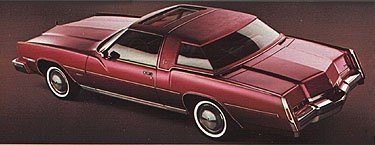
1978 XS
In '77 the Delta 88 and Ninety-Eight models, formerly the biggest cars in the Oldsmobile stable, were downsized. The Toronado would be the largest Oldsmobile, and, after the mid-sized Cutlass line's downsized for '78, the Toronado looked hopelessly out of place in the Olds lineup, given the industry-wide shift to smaller cars.
This generation was probably helped in the sales race by the radical and controversial "boat-tail" design of the contemporary Buick Riviera, since during this period the Toronado outsold its Buick cousin for the first time. However, the higher-priced Cadillac Eldorado managed to outsell the Toronado in most of these years.
1979-1985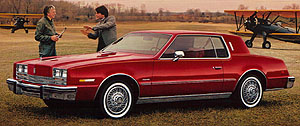 1984 Toronado Brougham |
1979 1980 1981 1982 1983 1984 1985 |
The third generation Toronado debuted in the fall of 1978 as a 1979 model. The car lost nearly 1,000 pounds and more than 20 inches in length, shrinking to a 114-inch wheelbase and an overall length of 204 inches, all the while gaining passenger space.
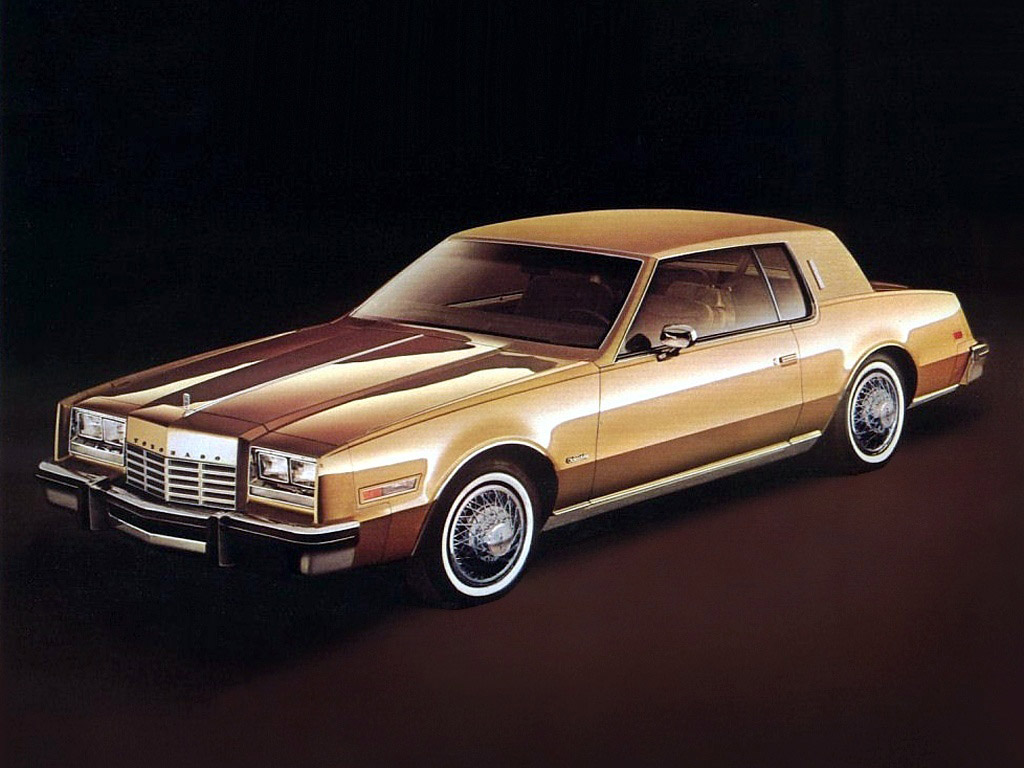
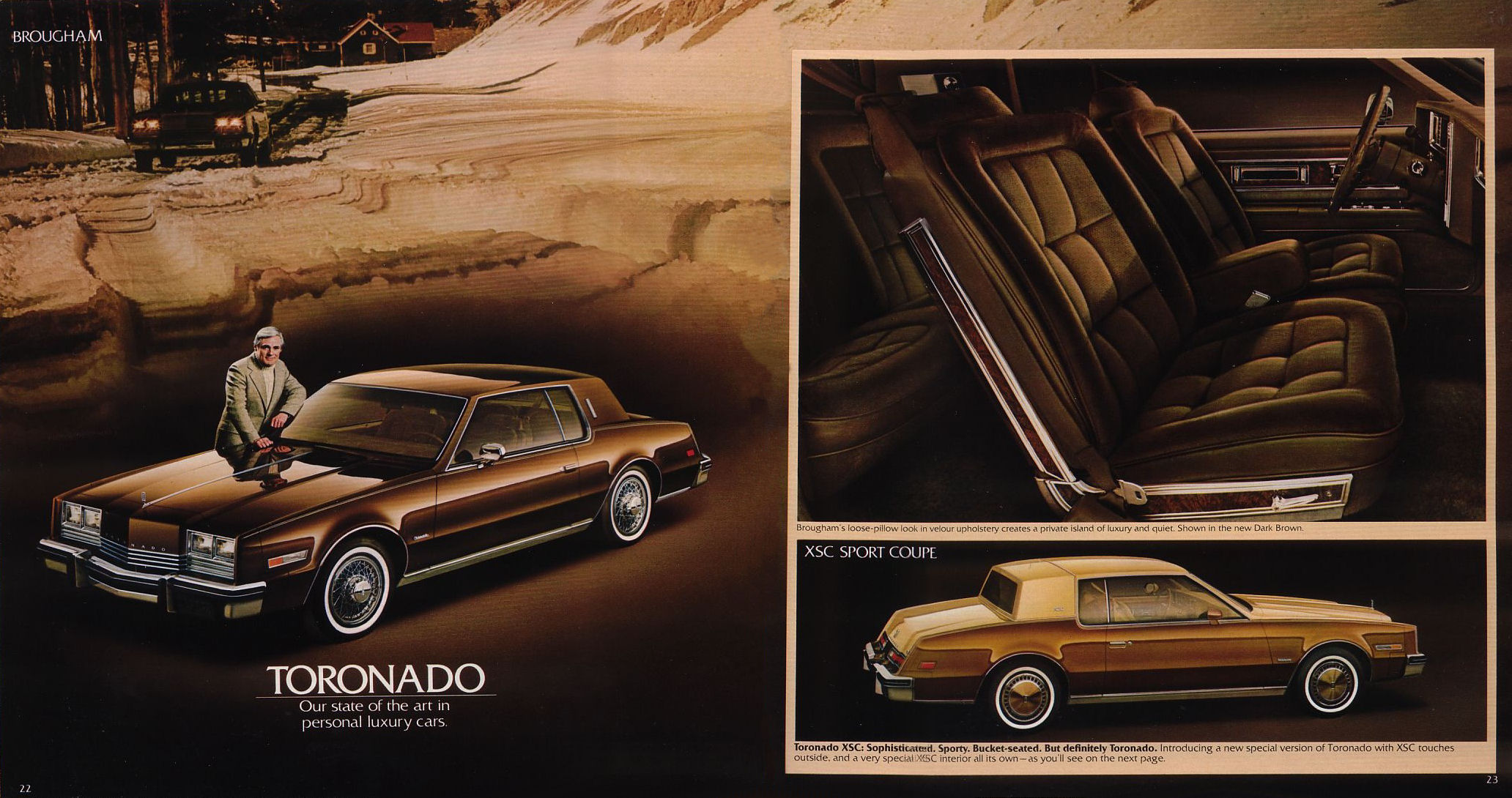
1979 1980
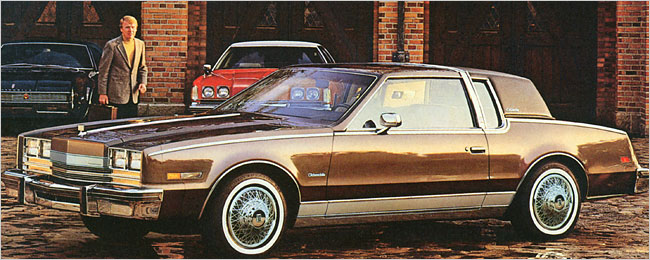
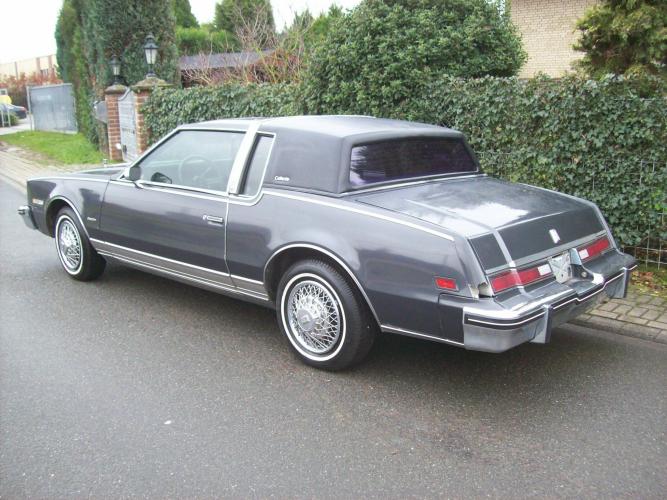
1984 1985
The newly-downsized Toronado came equipped with smaller engines than in previous years using the 350 cu in (5.7 L) Oldsmobile Rocket V8 and beginning in 1980, the 307 cu in (5.0 L). lable from 1981 to 1984, but it proved unpopular due to its slow acceleration. The Toronado was still a fairly heavy automobile, and it would take another downsizing before a six-cylinder engine of any kind could move it effectively.
Also offered in these years was Oldsmobile's new diesel V8, converted from Olds' well-regarded gasoline-powered 350 cu in (5.7 L) V8. This engine was novel and economical, and sales were initially good. Unfortunately, the diesel conversion acquired a terrible mechanical reputation, becoming a genuine black eye for Oldsmobile. Many cars which originally came diesel-equipped were eventually converted to gasoline engines when disgusted owners finally threw in the towel.
The three-speed Turbo Hydra-Matic automatic transmission was standard equipment from 1979 to 1981 and replaced by the four-speed Turbo Hydra-Matic 325-4L overdrive unit from 1982 to 1985. The 307 cubic-inch Rocket V8 was standard on 1985 Toronados.
Independent rear suspension (designed by Cadillac engineers) was adopted for the new car, which helped to increase usable rear-seat and trunk space in the smaller body, as well as improved handling over previous Toronados with no sacrifice in ride quality. Rear disc brakes were optional.
In addition to the base Toronado Brougham, various trim packages were available under the XSC (1980–81) and Caliente (1984–85) names that offered choices of velour or leather upholstery and digital instrumentation. The third-generation Toronado was also made into convertibles by the American Sunroof Company, with a power-operated cloth top. Reclining backrests were and option.
This Toronado, along with its Riviera and Eldorado cousins, were the last body-on-frame, front wheel drive cars with longitudinally-mounted V8 engines.
1986-1992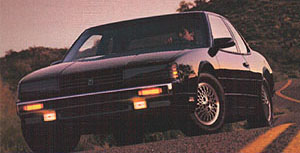 1989 Toronado Trofeo |
1986 1987 1988 1989 1990 1991 1992 |
The fourth and final generation of Toronado was on the market from 1986 to 1992. It was even smaller, lost its body-on-frame construction in favor of a unibody platform, and was the first Toronado since 1969 to feature hidden headlights.
V8 engines were gone, with the fuel-injected version of the Buick 231 cu in (3.8 L) V6, now the only powerplant available. A good, powerful engine, it was well-suited to this much smaller, lighter car.
Inside, a new digital instrument panel and optional voice alert system were employed and the same luxury trappings were offered as standard equipment and options as before. Standard seating was a cloth 60/40 bench with center armrest. For the first time since 1970, Strato bucket seats were offered as an option, and they included a full-length center console with a horseshoe-like "basket handle" gear shift similar to that found in some 1960s and 1970s Buicks and Chevrolets. Upholstery choices included cloth or leather.
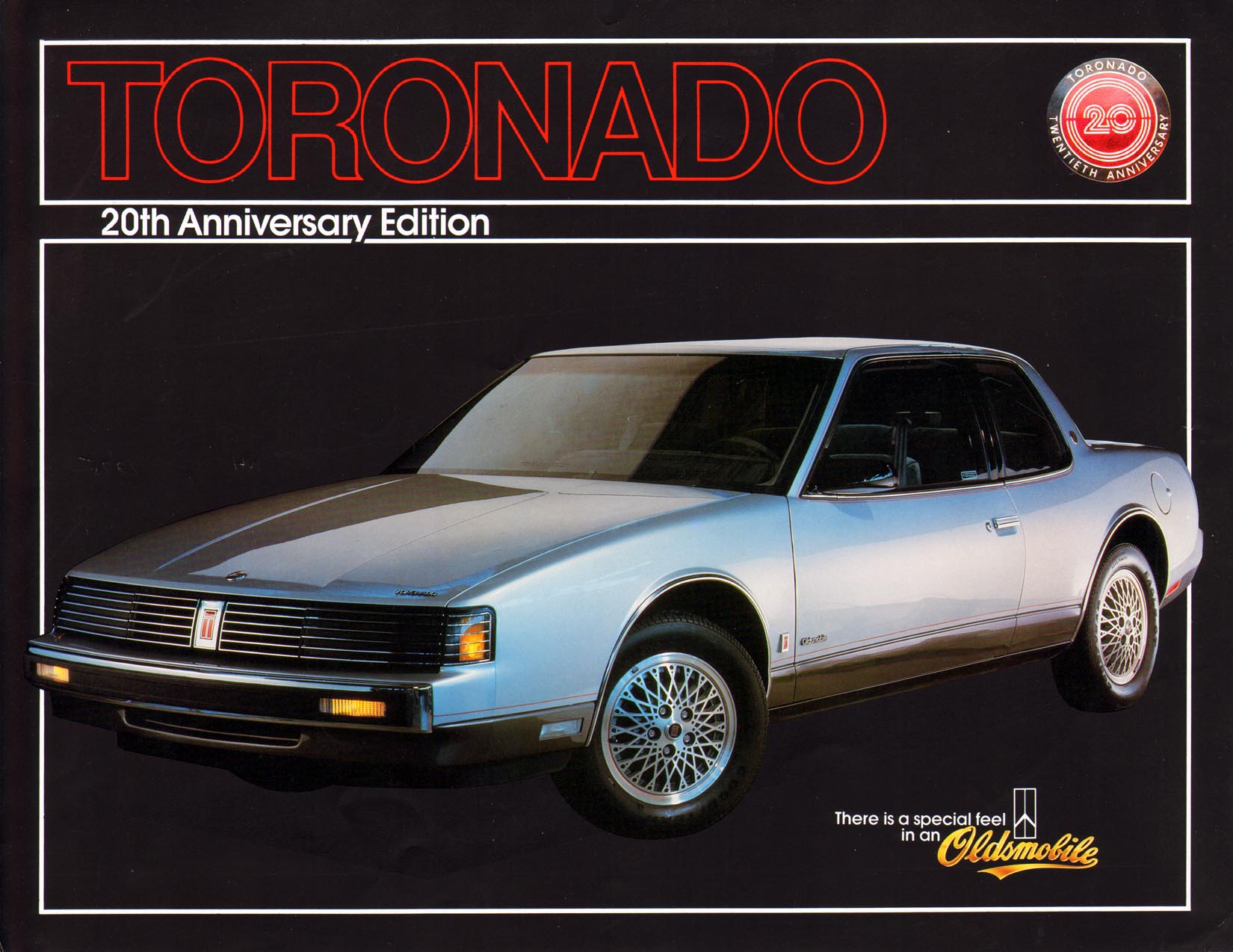
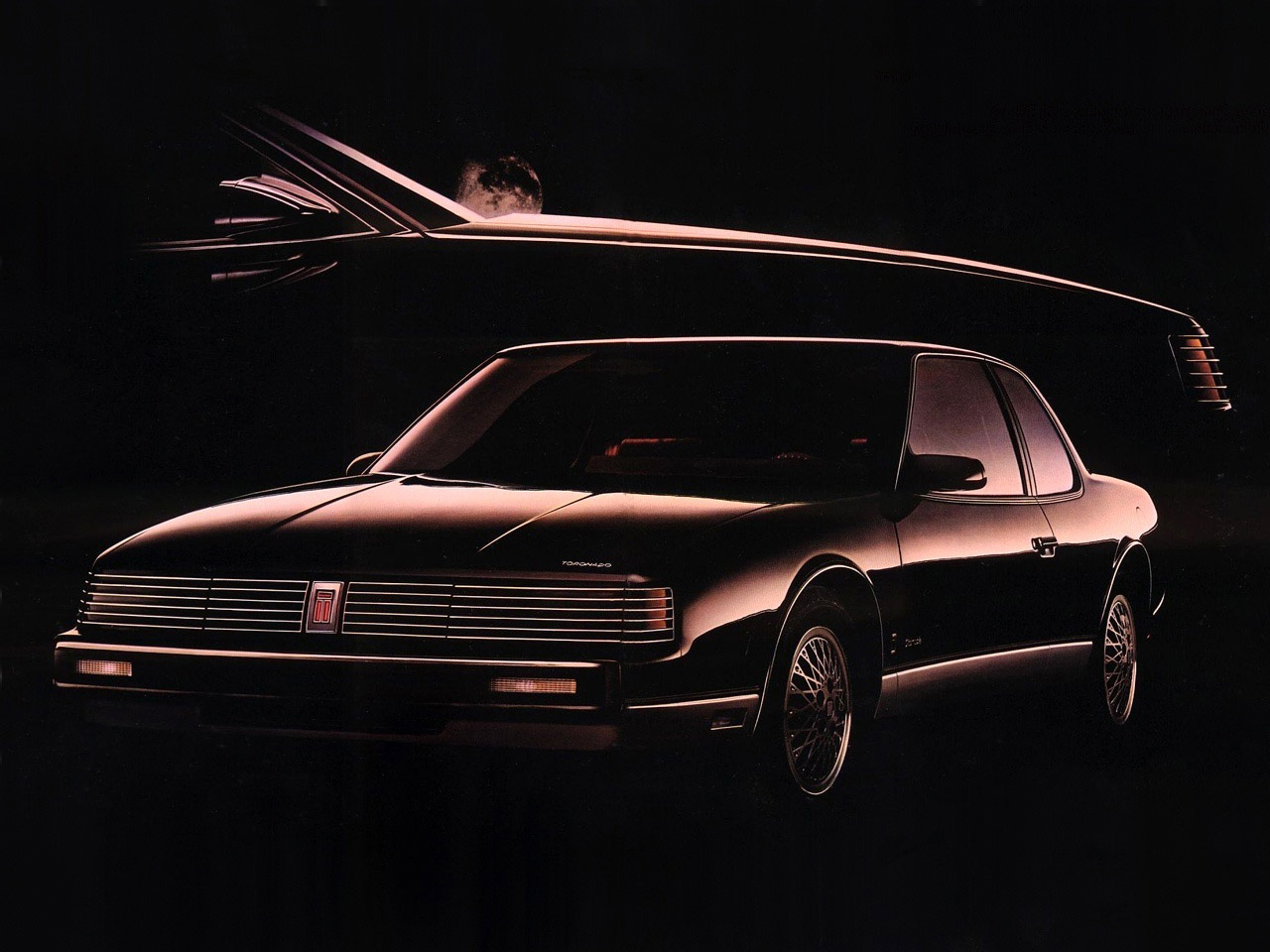
Unfortunately, GM's timing with this latest downsizing proved to be off the mark. Gasoline prices had dropped dramatically below $1.00 per gallon in many parts of the U.S. by the fall of 1985, against corporate predictions of it going to $3.00 and up. Buyers, faced with GM's new choices across the board, chose instead to "buy big" in 1986, with cars like the Lincoln Town Car and Chrysler's V8-powered Fifth Avenue setting sales records for the '86 model year.
Sadly, along with its shrunken sisters, the Eldorado and Riviera, the Toronado suffered a serious sales decline which would never be reversed. Critics blamed the downsizing, as well as "cookie cutter" styling that looked too much like the cheaper, less-luxurious compacts at GM, notably the Oldsmobile Calais and Pontiac Grand Am.
In mid-1987, Oldsmobile attempted to bolster sagging Toronado sales by introducing a sportier model called the Troféo, which boasted standard leather bucket seats, faux dual exhaust, more-aggressive styling, and a stiffer suspension (the highly-regarded corporate FE3 package, with retuned shocks, struts and other components).
For 1988, changes for the Troféo included new seats and monochromatic paint; both Toro and Troféo benefited from larger climate control buttons and rear three-point seatbelts. Additionally, power increased with the introduction of the new Buick 3800 LN3 V6 engine. Wire wheel covers were deleted from the options sheet. Other changes were minor and mainly cosmetic.
The 1989 Troféo, which was no longer badged externally as a Toronado, could be ordered with the Visual Information Center:: a dash mounted touch-screen CRT that controlled the vehicle's thermostat and radio and also supplied advanced instrumentation such as a trip computer. The 'VIC' could also serve as the interface to an in-car hands-free cell phone. Troféo also received standard anti-lock brakes and a new steering wheel that featured buttons for radio and climate controls. Toronados now had standard bucket seats with console, although the split-bench seat was still offered as an option
1990 saw Oldsmobile literally and figuratively going to great lengths to revive Toronado and Troféo sales. The hood was the only carryover piece of exterior sheetmetal as Olds designers completely redesigned the body, particularly in the rear, increasing the overall length by about 1-foot. While the redesign did not increase passenger space, it did answer criticism of the car's trunk space. Toronado/Troféo owners could easily carry enough luggage for a long vacation or four golf bags with room to spare.
On the safety front, for the first time since 1976, an airbag was installed, this time for the driver only, and it was standard equipment. It was fitted in a new steering wheel shared by both models. The new steering wheel framed the driver's view of new analog gauges and information center, as well. . Thanks to a larger glovebox, .the bulky owner's manual for the '90 Toro and Troféo had more room as well.
Unfortunately, the new look did not help stem the tide of sagging sales. Even so, Olds was not ready to throw in the towel just yet. The 1991 models added a couple of new features at no extra cost: previously optional remote: keyless entry and anti-lock brakes were made standard across the board. The engine got another small horsepower bump. Troféos got a new interior choice over the standard leather upholstery — Ultrasuede — which must have sold poorly, as it is extremely rare today. The moonroof option no longer required bucket seats to be ordered.
The '92 models debuted with a new old option: - wire wheelcovers. Fans could indulge themselves for the first time since 1987. Troféos got a stiffer standard suspension (the formerly-optional FE3 package).
Although the Toronado and Troféo were, by this time, as good as GM's designers and engineers could make them, buyers were not buying them since the "SUV craze" was in its infancy and personal luxury coupes, in general, were declining in sales. Oldsmobile management realized this, and decided to cancel the Toronado and Troféo at the end of the 1992 model year. They were replaced in the lineup by the Aurora sports sedan which debuted in early 1994 as a 1995 model.
The last Toronado rolled off the assembly line on May 28, 1992